VoIP / Multimedia over WiMAX (802.16)
Abstract
The paper discusses the implementation of Voice over IP (VoIP) and IP Multimedia Subsystem services (IMS) over the much sought after wireless standard WiMAX (802.16). The key issues addressed are : Introduction to the working of VoIP and multimedia transmission over wireless. The softswitching technique for compatibility with WiMAX.
The challenges being faced that need to be overcome for successful deployment and their solutions. The pre-standard installations and developments happening around the world at this time. The various products offered by the vendors compliant to the technology, and the impact of these developments on the existing Telecom and Satellite/CableTV industry.
Keywords - WiMAX, VoIP, Multimedia, IMS, 802.16, SIP, H.323, IPTV, Softswitch
See also: TCP Optimizations over Wireless | QoS for WiMAX |
Other Reports on Recent Advances in Networking
Back To Raj Jain's Home Page
- Introduction to VoIP
- Introduction to IMS
- WiMAX - Quality of Service (QoS)
- Impact on the Telecom and Satellite/Cable TV Industry
- Recently Launched Products
- Pre WiMAX Happenings and Industry Forecasts
- Summary
- References
- List of Acronyms
1.0 Introduction to VoIP
Ever since its advent VoIP has opened new doors for telephony bringing forward immense possibilities. The basic reason for the popularity of VoIP is the cost which is very low as compared to the conventional telephony services. The concept of transmission of voice over data stream makes it possible to have VoIP transmitted and received using anything that uses IP - laptops, PC's, WiFi enabled handsets etc..
1.1 How does VoIP work?
VoIP uses Internet Protocol for transmission of voice as packets over IP networks. The process involves digitization of voice, the isolation of unwanted noise signals and then the compression of the voice signal using compression algorithms/codecs.After the compression the voice is packetized to send over an IP network, each packet needs a destination address and sequence number and data for error checking.
The signaling protocols are added at this stage to achieve these requirements along with the other call management requirements. When a voice packet arrives at the destination, the sequence number enables the packets to be place in order and then the decompression algorithms are applied to recover the data from the packets. Here the synchronization and delay management needs to be taken care of to make sure that there is proper spacing.
Jitter buffer is used to store the packets arriving out of order through different routes, to wait for the packets arriving late.
1.2 Signaling Protocols
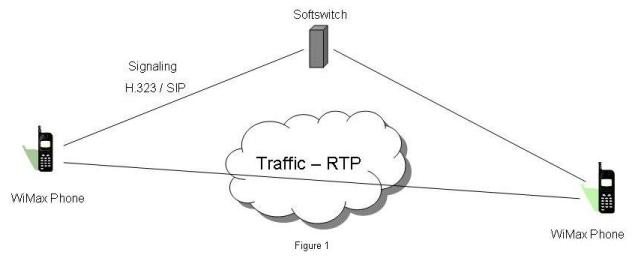
The signaling protocols H.323, SIP are used to setup the route for the transmission over the IP network, the Gateway protocols like the Media Gateway Control Protocol are used to establish control and status in the media and signaling gateways. Routing (UDP, TCP) and transport protocols (RTP) are used once the route is established for the transport of the data stream as shown in Figure 1
1.2.1 H.323
H.323 is the ITU-T standard for packet based multimedia communication, though originally developed for multimedia conferencing over LAN's it was later modified for VoIP as well. With versions coming out in 1996 and 1998, the standard has faced stiff competition from the other protocol SIP which was specifically designed for VoIP, but is more used because of its wide existence in the already installed networks. The standard is interoperable and has both point to point and multipoint capabilities.
H.323 uses a number of other sub protocols for the various functions.
- H.255.0 - Registration, Admission, Status, Call Signaling, Control
- H.245 - Terminal Capability Exchange, Media Description, Control of Logical Channel
Also H.323 offers specifications for call control, channel setup, codecs for the transmission of Real time video and voice over the networks where the QoS and guaranteed services are not available. For the transport RTP is used for real time audio and video streaming.
1.2.2 Session Initiation Protocol (SIP)
SIP is the IETF standard for VoIP signaling. It is based on the existing protocols like SMTP and HTTP, and uses a text based syntax that is comparable to HTTP uses in web addresses. A web address is comparable to a telephone number in a SIP network, also the PSTN phone numbers are also compatible in a SIP network ensuring interfacing with PSTN systems. SIP also provides a mobility function to the users.
SIP also supports multiple media sessions during a single call hence users can - share a game, use instant message (IM), and talk at the same time.
SIP works with most protocols like RTP, Session Description Protocol (SDP), Session Announcement Protocol (SAP). A lot of other protocols are also needed when it comes to the transport and signaling with the PSTN networks - RSVP, LDAP, RADIUS.
SIP works on a client server architecture, where the clients are referred to as User Agents (UA). UA interact with the server mainly through a PC with a telephony agent or IP phone. The servers are of four types :
- Registration
- Redirect Server
- Proxy Server
- UA server
The SIP messages used for communication between the client-server are INVITE, ACK, OPTIONS, REGISTER, CANCEL, BYE
1.3 Softswitch
The new innovation in switching - Softswitch is far less expensive both in terms of purchase and maintenance as compared to the conventional switches used in PSTN networks.
Interoperability is primarily the biggest cutting edge advantage that the service provider gets out of using a Softswitch. Softswitch is an enhancement over the existing gatekeeper technology which supported H.323, since H.323 was only restricted to LAN's the activities and capabilities of the gatekeeper were restricted to a few gateways which were managed by a single gatekeeper. As the networks became larger, there was a need for more efficient and smart solutions for managing all these services, which were answered by the softswitch. The softswitch coordinates the call control, signaling, and the other features that enables making a call across networks possible.It provides all the essential call control and service logic functions, coordinates routing of signaling messages between networks, it also provides all the administrative functions like billing statistics and providing other value added services to the users. The various
components of the Softswitch are described and shown in Figure 2:
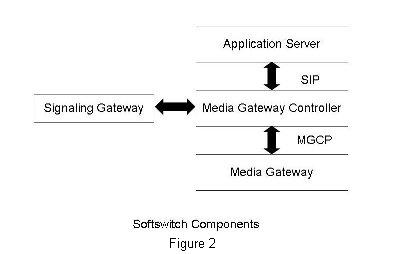
- Signaling Gateway
It serves as the intermediary between the IP and the PSTN networks. The gateway provides interoperability between the SS7 protocol used by PSTN networks and the SIP/ H.323 protocols used in VoIP.
- Media Gateway
They are used for the packetization of the circuit switched voice stream. Media Gateways are controlled by a Media Gateway Controller (Softswitch) which provides the call control and signaling functionality
- Application Server
It is responsible for all the services that the customer is provided with by the service provider like call voice mail, call forwarding.
1.4 Challenges Faced
1.4.1 Voice Quality
Presently, the telephone companies are losing so much of their business to the VoIP counterparts, but still the speculation exists on the kind of voice quality that VoIP service providers would give to customers.
The techniques used to measure the voice quality of a VoIP call are the Mean Opinion Score (MOS) and Perceptual Speech Quality Measurement (PSQM)
- MOS
MOS follows the measurement techniques specified in ITU-T P.800, where different people are made to listen the voice signals and are made to rate the factors like distortion, delay, echo, noise etc on a scale of 1 to 5 where 1 is the minimum and 5 being the maximum. The mean opinion score is then calculated. A value of MOS 4 is considered as the toll quality.
The conventional codec for fixed line telephones G.711 has a MOS of 4.0 at 64kbps. The modified codecs mainly used for VoIP are G.729 and G.723. G.729 is widely used for VoIP because of its low bandwidth requirements, it has
a MOS value of 4.0 operates at 8kbps. The G.723 which is mainly used for Video Telephony, has a MOS 3.8 and operates at 5.3 /6.8 kbps (Table 1)
- PSQM
Based on ITU-T P.861 standard, this technique uses artificial speech, to provides numeric values of approximate speech intelligibility taking into account effects such as noise, coding errors, packet reordering, phase jitter, and excessive bit error rate. PSQM=0 signifies no impairment, while PSQM=6.5 indicates that the signal is totally unusable.
Although PSQM values do not have any direct correlation with MOS values, but roughly PSQM value of 0 corresponds to MOS of 5 and PSQM value of 6.5 to MOS of 1.
The other factors affecting the voice quality are :
- Delay
Voice transmission over wireless brings along with a it a big problem of packet delay or latency. The factors that add to the delay are the Propagation delay, the serialization delay, channel coding delay at the physical layer and the Medium access delay at the MAC layer. Similarly at the Network layer the Forwarding and the Queuing delays are encountered,
and at the application layer Packetization / depacketization, delay, Algorithmic delay and look-ahead delay, decoding delay are inherently caused.
Studies have proved that packet delay of 100ms doesn't do any harm, but if the delay increases to 150ms the voice signal is unusable. The service providers have to ensure that the delay caused does not exceed 100ms by any ways. Table 1 [Orthman 05] shows the various CODECs along with their MOS and delay time.

- Packet Loss/ Dropped Packets
Packet loss does excessive damage to the voice signal, as retransmission cannot be considered as an option while transmitting voice.Loss of voiced frames at unvoiced/voiced transition causes significant degradation of the signal.
Advanced error detection and correction algorithms are used to fill the gaps created by the dropped packets. A sample of the speaker's voice is stored and is used to create a new sound from an algorithm which tries to approximate the contents of the dropped packets or lost packets.
- Jitter
When the transmission times of the arriving packets varies as a result of different queuing times or different routes it is referred to as Jitter. Jitter can be taken care of by using an adaptive jitter buffer which adapts itself according to the delay encountered over the networks, to provide a smooth voice stream at the output.
1.4.2 Security
Securing the voice communication is also a big challenge for VoIP over WiMAX as care has to be taken that it cannot be eavesdropped or intercepted.
The Double encryption process - X.509 for Authentication and 152-bit AES, 3DES or 56-bit DES for data flow ensure the transmission is secure and eavesdropping is very difficult on the traffic.
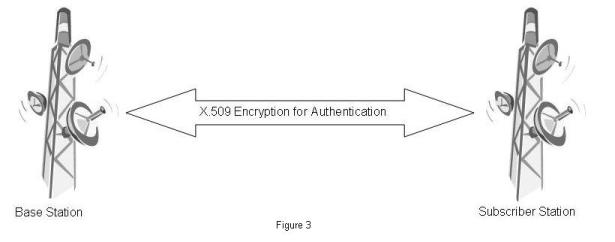
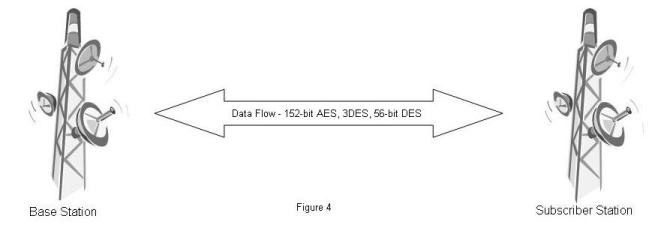
When a Subscriber Station (SS) needs to associate with a Base Station (BS), it sends an authorization request along with authentication information in a X.509 certificate (Figure 3). The BS after verifying the certificate responds by sending the authorization message which has the authorization key encrypted with subscriber's public key, to enable the subscriber to register with the network. An IP address is given to the SS by the DHCP. The DHCP server also provides the address of the TFTP server, from where the SS gets the vendor specific configuration information file. After this, the BS accepts the subscriber. The data stream is further encrypted using 56-bit DES, 3DES or 152-bit AES (Figure 4).
This prevents the possibility of eavesdropping on the data and theft of service as the links between the BS and SS are encrypted. Also WiMAX has built in virtual LAN (VLAN) support which provides protection for data transmitted by multiple users on the same BS.
1.4.3 E911/CALEA Support
-
E911 Support
Emergency support is one of the primary requirements that the service providers have to ensure to their customers, as per the Law in United States. Though the solution already exists for fixed line phones, which works by registering the IP phone with the PSTN's PSAP database. For mobile phones this method would need re-registering the phone to the new location every time the location changes. There are various other ways which are being considered for the implementation of the same for mobile phones. Most of them need special chips that would be imbedded in IP devices that support VoIP. The ideas talk about using GPS technology in a WiMAX enabled handset to pin point its exact location, technique focusing on using signal maps of the U.S. drawn by driving streets and recording the patterns of privately owned wireless access points. The chips built in IP devices would supply the pattern they receive and the patterns can be then compared with the database to correlate signal patterns to locations.
- Communications Assistance to Law Enforcement Agencies Support
This aspect needs two important requirements to be fulfilled, collection of call details and the collection of the contents of the call. The first part is easy to implement as the softswitch employed by the service providers do provide call records and details for billing and administrative purposes. The second part is a little harder to implement as the voice is transmitted in the form of packets. Considering the law was developed for the Circuit Switched world, somewhere in the year 1994, there are speculations that the law would be relaxed for the VoIP telephony.
2.0 IP Media Subsystem Services - IMS
Today WiMAX is the only standard capable of providing the Quadruple play Technologies - Data, Voice, Video, Mobility (802.16e) using a single network. Collectively these services are referred to as IP Media Subsystem Services - IMS (Figure 5)

2.1 WiMAX IPTV
Uses the simple principle of converting a TV program to IP. This packetized program is streamed to the viewer, who can easily view it using a normal TV along with a Set Top Box (STB) as shown in Figure 6.
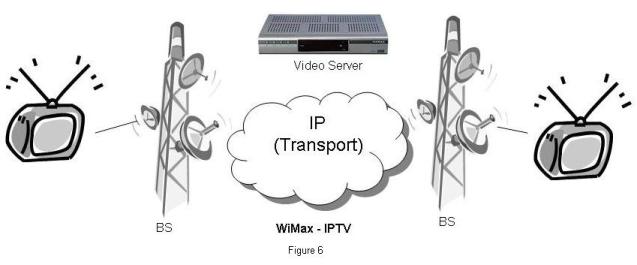
2.2 Wimax IPTV - How Does it work?
IPTV service providers have secured agreements with national broadcasters and programmers to offer all the channels currently being offered by the Cable/Satellite TV companies. The process involves receiving the programs directly from the broadcasters after encoding it into MPEG-2 format at a constant bit rate. The MPEG-2 stream is encapsulated into UDP/IP and is then sent as individual multicast streams to satellite uplink. The IP QoS is also applied by the IP streaming platform. These IP multicast streams are then uplinked to the IPTV service provider's satellite in a Digital Video Broadcasting (DVB) Format. The service provider has all the required setup for the converting the DVB format back into the IP, who delivers the video streams an IP or encapsulated as ATM providing superior viewing quality to the customer. There is also an option of providing on site encoding services for streaming of off-air programming.
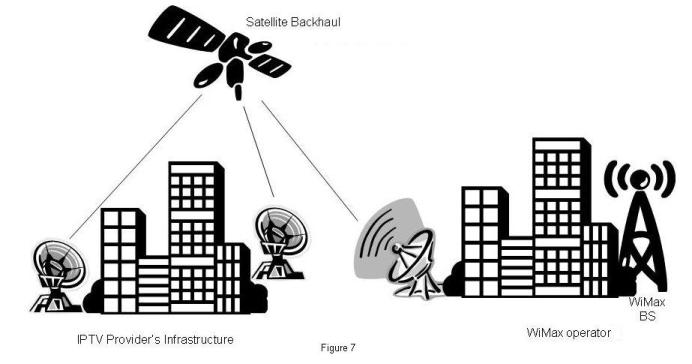
2.3 Services Offered
-
2.3.1 Video on Demand: The trend of downloading movies through video streaming already here, the advent of WiMAX would take the online movie sharing further to the next level
- 2.3.2 Personal Video Recorder: The popularity of the PVR's would also increase with WiMAX, making features such as pausing, replaying Live TV, skipping commercials which are just being introduced today, more common.
-
2.3.3 PC - TV: The faster speeds of internet would make PC-TV a more richer experience as well.
WiMAX provides Quality of Service at both physical and MAC layer using the following techniques:
- Physical Layer
- Frequency division duplex (FDD) - The application of frequency-division multiple access to separate outward and return signals. The uplink and downlink sub-bands are said to be separated by the "frequency offset". Frequency division duplex is much more efficient in the case of symmetric traffic.
- Time division duplex (TDD) - The application of time-division multiple access to separate outward and return signals. Time division duplex has a strong advantage in the case where the asymmetry of the uplink and downlink data speed is variable.
- Forward Error Correction (FEC) - The technique to allow the receiver to correct some errors without having to request a retransmission of data.
- Orthogonal frequency-division multiplexing (OFDM) - The frequencies and modulation of FDM are arranged to be orthogonal with each other which eliminates most of the interference between channels.
- Orthogonal Frequency Division Multiple Access (OFDMA) - It works by assigning a subset of subcarriers to individual users.
- MAC Layer - Service Types
- Unsolicited Grant Service (UGS) - Supports Real Time data streams, having fixed size packets issued at regular intervals e.g.. VoIP
- Real Time Polling Service (rTPS) - Supports Real Time data streams, having variable size packets issued at regular intervals e.g.. MPEG Video
- Non Real Time Polling Service (nrTPS) - Supports delay tolerant data with variable packet sizes, for which a minimum data rate is specified e.g.. ftp
- Best Effort (BE) - Supports data streams where no minimum service is required and packets are handled on a space-available basis
4.0 Impact on the Telecom and Satellite/Cable TV Industry
The Quadruple Play as we call it, will definitely have a catastrophic effect on the existing Telecom and Satellite/Cable TV Industry. The reasons being
- A Wimax network is a lot less expensive to deploy as compared to the conventional PSTN and the Cable TV networks. It is highly flexible supporting several architectures, provides point to point and point to multipoint access.
- The equipment is much more simpler, smaller in size and a lot convenient to handle.
- Highly Secure network by means of complex handshakes, X.509 certificates and use of AES, 3DES encryptions
- Ease of deployment and portability, as no hassles of wiring is involved.
- WiMAX uses different modulation schemes - BPSK, QPSK, 16-QAM, 64-QAM. While low level modulations (BPSK, QPSK) provide wider coverages the higher ones (QAM-64) provide high capacity. WiMAX also provides Non Line of Sight (NLOS) operation using OFDM and OFDMA technology.
The one solution to all the Data, Voice, Video, Mobility services is definitely a big plus point for the consumer.
WiMAX leaves behind all the competing technologies such as Fiber to the Home (FTTH), Broadband over Power Lines (BPL), xDSL, High-Speed Downlink Packet Access or 3.5G (EvDoHSPDA), Enhanced Data rates for GSM Evolution (EDGE) by miles, as none of these technologies provide all the services the way WiMAX can. Therefore WiMAX emerges as the best available solution for these services
5.0 Products Available
All the pro
dcts can be found at http://www.wimaxforum.org/kshowcase/view
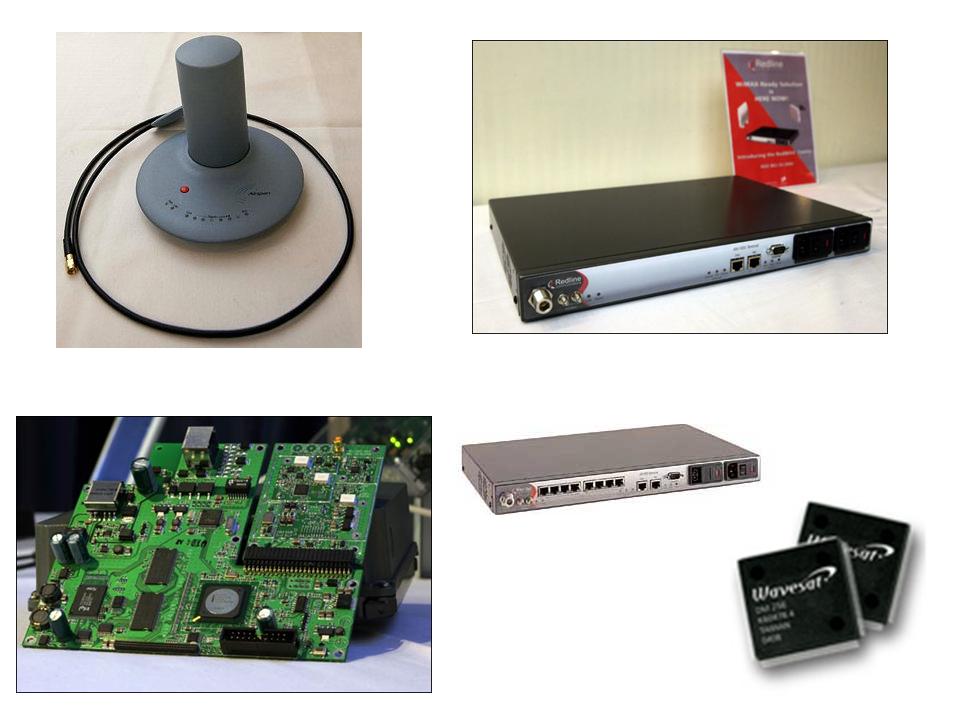
Base Stations
- Aperto Networks' PacketMAX 5000
- Redline Communications' RedMAX AN-100U
- Sequans Communications' SQN2010 SoC
- Siemens' WayMAX@vangtage IDU/3.5 GHz FDD ODU
Subscriber station
- Wavesat's miniMAX customer premise equipment (CPE)
- Siemens' Gigaset SE461 WiMAX
Mobile Phones
- Nokia set to launch WiMAX enabled cell phones by 2007
Products are also being offered by Adaptix, Axxcelera Broadband Wireless, Proxim Wireless, Orthogon Systems and Alvarion.
7.0 Summary
In this paper, we discussed the transmission of VoIP and IMS over WiMAX, the changes required in the existing protocols. The working of a Softswitch which makes VoIP over WiMAX possible. The possible challenges encountered and their solutions.
Working of Wimax IPTV. The effects of the advent of quadruple play offered by WiMAX on the existing telecom and Cable TV industry. Lastly we looked into the products being launched compliant to the standard and some pre standard implementations happening around the world.
8.0 References
9.0 List of Acronyms
- AES - Advanced Encryption Standard
- ATM - Asynchronous Transfer Mode
- BE - Best Effort
- BPSK - Binary Phase Shift Keying
- BPL - Broadband over Power Lines
- BS - Base Station
- CALEA - Communications Assistance to Law Enforcement Agencies
- CPE - Customer Premise Equipment
- DES - Data Encryption Standard
- DVB - Digital Video Broadcasting
- E911 - Emergency 911
- EDGE - Enhanced Data rates for GSM Evolution
- EvDoHSPDA - High-Speed Downlink Packet Access or 3.5G
- FTTH - Fiber To The Home
- GPS - Global Positioning System
- HTTP - Hyper Text Transfer Protocol
- IETF - Internet Engineering Task Force
- IMS - IP Media Subsystem Services
- ITU - International Telecommunication Union
- LAN - Local Area Network
- LLDP - Link Layer Discovery Protocol
- MGCP - Media Gateway Control Protocol
- MOS - Mean Opinion Score
- MPEG - Moving Picture Experts Group
- nrTPS -non Real-time Polling Service
- OFDM - Orthogonal Frequency Division Multiplexing
- OFDMA - Orthogonal Frequency Division Multiple Access
- PSAP - Public Safety Answering Point
- PSQM - Perceptual Speech Quality Measurement
- PSTN - Public Switched Telephone Network
- QAM - Quadrature Amplitude Modulation
- QoS - Quality of Service
- QPSK - Quadrature Phase Shift Keying
- RADIUS - Remote Authentication Dial In User Service
- RSVP - Resource ReSerVation Protocol
- RTP - Real-time Transport Protocol
- rTPS - Real-time Polling Service
- SAP - Session Announcement Protocol
- SDP - Session Description Protocol
- SIP - Session Initiation Protocol
- SMTP - Simple Mail Transfer Protocol
- SS - Subscriber Station
- STB - Set Top Box
- TCP - Transmission Control Protocol
- UDP - User Datagram Protocol
- UGS - Unsolicited Grant Service
- VLAN - Virtual LAN
- VoIP - Voice over IP
- WiMAX - Worldwide Interoperability for Microwave Access
- xDSL - collective term for ADSL, SDSL and HDSL
Last Modified on : April 24, 2006
Note: This paper is available online at http://cse.wustl.edu/~jain/cse574-06/wimax_voip.htm









